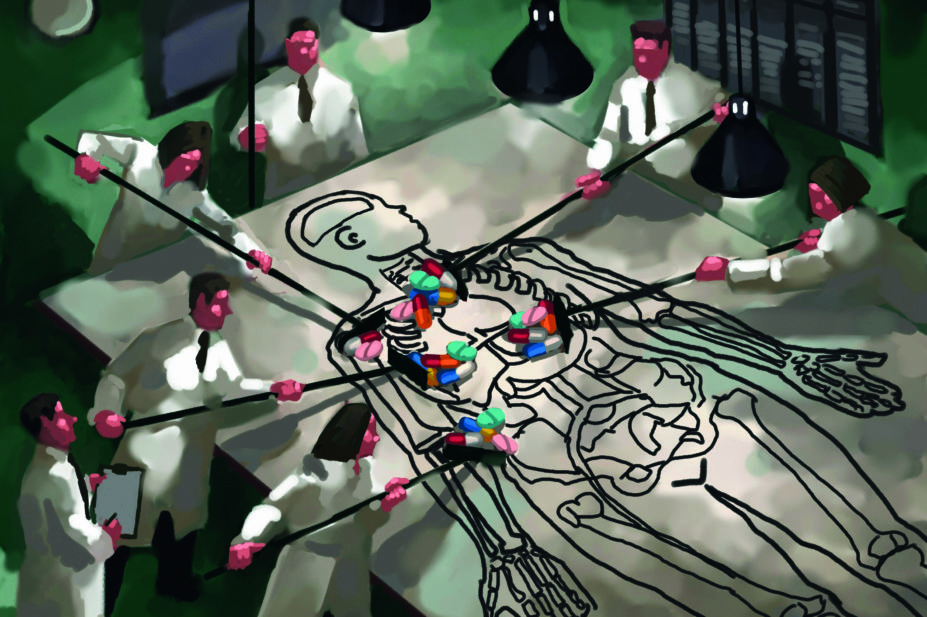
Ikon Images / Alamy Stock Photo
Patients with a rare disease continue to face unmet need in the UK. Only 5% of rare diseases have a licensed treatment option[1]
and one in three children with a rare disease will die before the age of 5 years[2]
.
Rare diseases are still being discovered[3]
, so finding innovative medicines for these conditions is increasingly important. However, small patient populations present unique challenges in the research, development, and reimbursement of these medicines.
In response to this unmet need and the difficulty facing innovators, the EU introduced legislation in 2000 to incentivise the research, development and marketing of orphan medicines. We now see the impact of this change. Between 2002 and 2005, just one orphan drug was licensed each year. But 17 orphan drugs were licensed in Europe in 2014 alone[4]
.
This progress has created new challenges for payers, who must now adapt their appraisal methods to account for the new innovations.
Keeping up with the pace of change
In 1999, the UK government set up the National Institute for Health and Care Excellence (NICE). The goal of the new body was simple: deliver recommendations for independently valued, cost-effective treatments to the NHS. NICE’s methods have often worked well, especially for condition areas with large patient populations.
However, in January 2016, in a speech to the House of Commons, the then life sciences minister, George Freeman, spoke of the “phenomenal revolutions in genomics and informatics and in the pace of discovery”, which “give rise to great challenges: rising costs of treatment; ever more expensive drugs; smaller patient catchments, which puts a coach and horses through the traditional model of reimbursement; and the end of the one-size-fits-all blockbuster model of drug discovery, which is what NICE was originally set up to deal with”[5]
.
The NHS has struggled to keep up with these challenges, which are frequently faced by orphan medicines[6]
— a pressing issue for the 3.5 million people affected by rare diseases in the UK[7]
.
The latest Pharmaceutical Price Regulation Scheme (PPRS) was intended to give the government the flexibility it needed to adapt to the pace of change, and allow the NHS to innovate, by capping the overall spend on branded medicines by companies who have signed up to the agreement[8]
. When this cap is breached, manufacturers provide a rebate; industry has paid back over £1.7bn since 2014[9]
. Theoretically, this protects the NHS against any growth in the medicines budget.
Unfortunately, theory has not translated into reality. The NHS and NICE have been unable to exploit this flexibility because the rebate is not paid back directly to medicines purchasers, but is repaid to central government. By contrast, in Scotland, the rebate is paid directly into the New Medicines Fund, which makes treatments for rare or end-of-life conditions.
The wrong solution
Having not realised the full potential of the PPRS, NHS England and NICE recently set out new proposals that threaten a break from the traditional role of NICE in appraising which medicines should be paid for by the NHS[10]
.
The changes — implemented from April 2017 onwards — will, for the first time, see the health service set a policy that can explicitly restrict NHS funding for the treatments NICE decides are cost-effective. Where a technology exceeds the proposed £20m budget impact threshold, NHS England will be able to restrict its use, even if it meets NICE’s criteria for cost-effectiveness. This proposal could create new barriers for patients with rare conditions who already struggle to gain access to treatments.
Of more concern, the proposals also recommend introducing a new cost per quality-adjusted life years (QALY) threshold of £100,000 for treatments being appraised under the highly specialised technology (HST) process. After consultation, NICE and NHS England have introduced a modifier, which could raise the threshold to £300,000 for some HSTs.
However, the required quality-of-life improvements are likely to be unobtainable for patients with life-long genetic diseases. The charity Genetic Alliance highlights that no ultra-orphan treatments (drugs that are used to treat extremely rare diseases) currently used by the NHS would pass this new test[11]
.
An urgent rethink is needed before these new policies, focused almost exclusively on price to the detriment of patient outcomes, are taken any further
Setting aside the lack of clear rationale behind either the HST threshold or the budget impact threshold, the treatments that the HST process assess are, by their very nature, unsuitable to be valued using cost per QALY, owing to limited clinical evidence, uncertainties about the disease and the lack of standard utility measures for rarer diseases[12]
. An urgent rethink is needed before these new policies, focused almost exclusively on price to the detriment of patient outcomes, are taken any further.
The strength of the patient voice on this topic makes clear its importance. Voluntary support group the Society for Mucopolysaccharide Diseases (MPS) describes the decision as “devastating”[13]
and the Genetic Alliance argues that the “proposals will halt future access to innovative treatments for rare genetic conditions in England”[14]
. Several parliamentarians have also heavily criticised the proposals. MP Ben Howlett highlighted that the proposals contrast with the aim of the UK Strategy for Rare Diseases to ensure “that there are appropriate procedures for evaluating the costs and benefits of treatments for patients”[15]
.
We should draw lessons from other UK procurement processes that focus predominantly on price. The tender process for haemophilia and other blood products has historically focused on price as its main criterion[16]
. A 2016 paper by the London School of Economics, which examined this tender process, warned against the evolution of a healthcare system that could “come to focus exclusively on minimising the purchase price of treatments at the expense of quality and ongoing product and service innovation”[17]
. Instead, the paper suggests that the strategic thinking underlying the 2014 European procurement directive should be made central within NHS decision-making. This thinking revolved around the concept of the ‘most economically advantageous tender’ (MEAT) principle, which involves assessing the ‘whole life’ value of any technology. Adopting this principle would allow a balance between promoting affordability and incentivising innovation.
Instead of introducing changes focused on price containment, NICE and NHS England should be focused on adhering to the warning of the Accelerated Access Review and developing an appropriate appraisal method for all orphan and ultra-orphan medicines
Accounting for rarity
Beyond the concerns outlined, existing NICE processes already create significant barriers to accessing medicines for patients with rare conditions.
Increasingly, treatments – particularly those designated as orphan medicines – are not eligible for the narrow criteria of the HST process but are not appropriate for the single technology appraisal (STA) process either. This can be because the treatment’s patient population is marginally higher than the maximum population size considered through an HST, or the number of treatment centres is too high for the treatment to be considered as specialised. The STA process is inappropriate for most orphan drugs because of limited trial data; the diversity of the patient populations; uncertainties about the disease; or the lack of standard utility measures for orphan diseases.
In October 2016, the final report of the Accelerated Access Review (AAR) — which aims to speed up access to innovative drugs, devices and diagnostics for NHS patients — warned against this exact situation, stating that: “It is important that no groups of products can ‘fall between the cracks’ and struggle to find a decision-making process[18]
.”
Instead of introducing changes focused on price containment, NICE and NHS England should focus on adhering to the AAR’s warning and developing an appropriate appraisal method for all orphan and ultra-orphan medicines.
Opportunities for change
All healthcare organisations must make a committment to the robust and fair evaluation of all treatments for use in the NHS, not just those for common conditions. In line with current NHS policy as set out in the ‘Five year forward view’, this should include a recognition of a broad measure of value that goes beyond price alone[19]
.
The AAR lays the foundations for this commitment and recommends that NICE should undertake a review of its methods and processes to ensure that they are fit for purpose. As this process continues, NHS England and NICE need to reconsider how they account for rarity in their assessment processes to support the NHS in its mission to provide a comprehensive service, available to all, including those with rare conditions. Shire, which specialises in rare disease drug research, has responsibility to be a constructive partner in discussions on such issues, and ensure all patients have equity of access to treatments. In light of this, our 2017 report ‘Equity and access: making the UK a rare disease leader’ examines best practice in countries such as France and Germany, and outlines 13 recommendations to help the lives of those living with a rare disease[20]
.
By adopting more flexible approaches to the appraisal of rare disease treatments, the health service in the UK has potential to remain one of the most coveted providers of care in the world for patients with rare diseases, and to set the agenda on good care in the future. The ‘Next steps on the five year forward view’ publication made a welcome commitment to the development of an implementation plan for the UK Strategy for Rare Diseases in England.
Only through a flexible appraisal process for orphan medicines will this strategy achieve its ambition of ensuring that “no one gets left behind just because they have a rare disease”[21]
.
Sebastian Stachowiak is head of UK & Ireland country cluster and general manager UK at Shire, a specialty biopharmaceutical company.
Disclosure: Shire Pharmaceuticals UK provided funding to an agency for assistance in writing this article.
References
[1] Orphan Europe. About Us. November 2016. Available at: http://www.orphan-europe.com/about-us/orphan-drugs (accessed April 2017)
[2] Global Genes. RARE diseases: facts and statistics. Available at: https://globalgenes.org/rare-diseases-facts-statistics/ (accessed April 2017)
[3] Department of Health. The UK strategy for rare diseases. Available at: https://www.gov.uk/government/uploads/system/uploads/attachment_data/file/260562/UK_Strategy_for_Rare_Diseases.pdf (accessed April 2017)
[4] European Medicines Agency. Record number of medicines for rare diseases recommended for approval in 2014. Available at: http://www.ema.europa.eu/docs/en_GB/document_library/Press_release/2015/01/WC500180149.pdf (accessed 6 April 2017)
[5] HC Deb. c534WH. 19 January 2016. Available at: https://www.theyworkforyou.com/whall/?id=2016-01-19b.534.0 (accessed April 2017)
[6] NHS England. Improving outcomes through personalised medicine. Available at: https://www.england.nhs.uk/wp-content/uploads/2016/09/improving-outcomes-personalised-medicine.pdf (accessed April 2017)
[7] Rare Disease UK. What is a rare disease? November 2016. Available at: https://www.raredisease.org.uk/what-is-a-rare-disease/ (accessed April 2017)
[8] Department of Health. The Pharmaceutical Price Regulation Scheme 2014. Available at: https://www.gov.uk/government/uploads/system/uploads/attachment_data/file/282523/Pharmaceutical_Price_Regulation.pdf (accessed April 2017)
[9] Department of Health. 2014 Pharmaceutical Price Regulation Scheme (PPRS): aggregate net sales and payment information February 2017. Available at: https://www.gov.uk/government/uploads/system/uploads/attachment_data/file/596328/2016_Q4_PPRS_Feb_17.pdf (accessed April 2017)
[10] NHS England/NICE. Consultation on changes to technology appraisals and highly specialised technologies. Available at: https://www.nice.org.uk/about/what-we-do/our-programmes/nice-guidance/nice-technology-appraisal-guidance/consultation-on-changes-to-technology-appraisals-and-highly-specialised-technologies (accessed April 2017)
[11] Genetic Alliance. Changes to the HST Programme, March 2017. Available at: https://www.geneticalliance.org.uk/news-events/news/changes-to-the-hst-programme/ (accessed April 2017)
[12] UCL School of Pharmacy. Affording the future? November 2016. Available at: http://www.ucl.ac.uk/pharmacy/departments/practice-policy/affording-the-future.pdf (accessed April 2017)
[13] MPS Society. Press release – NICE and NHS England’s decision to deny access to new medicines is no April Fool’s Joke, March 2017. Available at: http://www.mpssociety.org.uk/2017/03/28/press-release-nice-nhs-englands-decision-deny-access-new-medicines-no-april-fools-joke/ (accessed April 2017)
[14] Genetic Alliance. Letter to Jeremy Hunt MP, March 2017. Available at: https://www.geneticalliance.org.uk/news-events/news/letter-to-jeremy-hunt-mp/ (accessed April 2017)
[15] Hansard. HC Deb vol 624 col 99WH (28 March 2017). Available at: https://hansard.parliament.uk/commons/2017-03-28/debates/B6E00098-C8E6-4675-8787-6BF510E2B2CD/RareDiseasesStrategy (accessed April 2017)
[16] World Federation of Haemophilia. Guide to national tenders for the purchase of clotting factor concentrates. Available at: http://www1.wfh.org/publication/files/pdf-1294.pdf (accessed April 2017)
[17] London School of Economics. Tender Loving Care? Available at: http://eprints.lse.ac.uk/67824/1/Tender%20Loving%20Care%20embargo%2010%20Nov%202016.pdf (accessed April 2017)
[18] Department of Health. Accelerated access review: final report. Available at: https://www.gov.uk/government/uploads/system/uploads/attachment_data/file/565072/AAR_final.pdf (accessed April 2017)
[19] NHS England. Five Year Forward View. October 2014. Available at https://www.england.nhs.uk/wp-content/uploads/2014/10/5yfv-web.pdf (accessed April 2017)
[20] Shire. Equity and access: making the UK a rare disease leader, March 2017. Available on request.
[21] Department of Health. The UK strategy for rare diseases, 2013. Available at: https://www.gov.uk/government/uploads/system/uploads/attachment_data/file/260562/UK_Strategy_for_Rare_Diseases.pdf (accessed April 2017)


